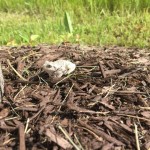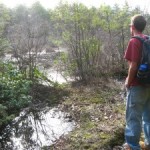If you live in the city and you hear a strange new noise this summer, it might be a gray tree frog that’s moved to your neighborhood. According to an article by Sharon Woods Harris in the Pekin (Ill) Daily Times, tree frogs are moving to the city because of recent high rains, which have left pools of water that are like vernal pools: females can lay their eggs in the pools without fear of fish eating them.
Gray tree frogs are typically found in woodsy, wet areas, but this year they’ve been found hanging out on decks and crawling up the sides of houses. The gray tree frog is a good climber—it can scale glass with the use of its enlarged toe pads. It catches insects and other invertebrates for food so street lamps or other city lights are great bug-catching places.
Gray tree frogs can be found in most of the eastern half of the United States, as far west as central Texas. They can also be found in Canada in the provinces of Quebec, Ontario, and Manitoba, and New Brunswick.
Once the heavy heat of July comes and the water dries up, the frogs will probably return to cooler, moist areas. In the meantime, if you live in the city, keep your ears open for the distinctive trill of the male tree frog calling for a mate.






The Austria frogs colonize natural habitats.
Salzburg in Austria, we find the tree frog rather at low altitudes, eg in Flachgau and Tennengau Pinzgau and in the Salzach valley west of Zell am See. The distribution type of tree frog is out of Alpine. The vertical penetration in Austria, with few exceptions, 200-1200 m. He settled wet meadows, riparian forests and grasslands. Preferred habitat structures are Saumbiotope, forest edges, clearings, hedgerows and thickets. Tree frogs are found especially in flat terrain in the southeast and exposed locations or in areas with well developed herbaceous and shrub layer looser. As temporary aquatic habitats, standing waters with predominantly shallow water and lush, predominantly vertical plant structures (eg rushes) are preferred.
Hi Hilde, Thanks so much for keeping us posted on your region… Susan